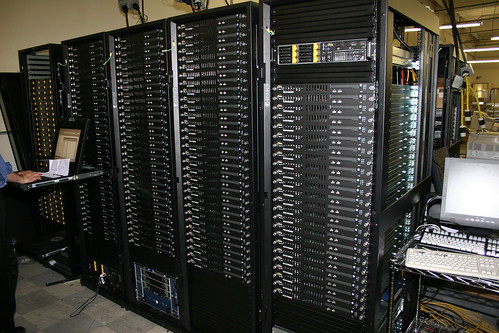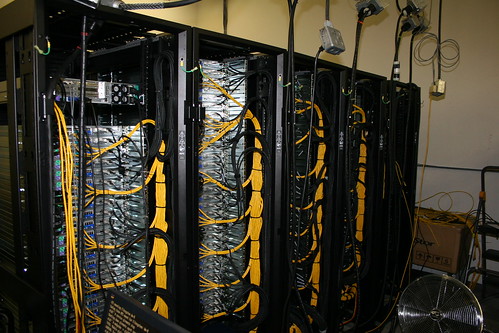About this time five years ago, I was a nervous junior undergraduate studying Biomedical Engineering at Tulane University. I had just been accepted as an undergraduate member of Dr. Natalia Trayanova’s computational cardiac electrophysiology lab. The goal at that time was to complete a research project for my undergraduate thesis.
So very many things have happened since then. Here are the highlights:
- 2002: Started learning the ropes of the lab
- 2003: Continued to familiarize myself with the computers and code in use in the lab. The most powerful machine in our possession was an SGI with 8 processors (the Origin 300 listed here). There was almost always a wait to use those processors. Spent my summer vacation working in the lab. This was the first time I was paid to to research. Some time during this year (I think) I created the lab wiki using MoinMoin. By this time I was administering the lab computers and was sick of answering the same questions over and over. In desperation I created a wiki and started putting answers on it, referring people to the wiki when I was asked a question. The wiki is now (as of November 2007) huge, and contains basically all of the documentation of everything used in the lab, as well as gigabytes upon gigabytes of attached models, data, and images.
- 2004: Graduated from Tulane with my Bachelor of Science in Engineering (BSE) degree. Joined the lab as a graduate student. Sometime in 2004 (I think), Tulane acquired a Linux Networx cluster, and we owned 20 nodes in that cluster.
- 2005: Shortly after returning from my trip to Niger, Katrina struck New Orleans. The lab was scattered. Few people in the lab had access to their data. A few lab members actually snuck past armed guards to get our file servers and some workstations from our lab at Tulane. We took up residence in St.Louis, MO for two and a half months, aided by our colleagues in the labs of Drs. Yoram Rudy and Igor Efimov at Washington University. By the end of the year, we had returned to a slowly-recovering New Orleans.
- 2006: Dr. Trayanova accepted a position as a professor at Johns Hopkins University. Almost the entire lab transfered to JHU and moved to Baltimore, MD.
- 2007: In April, I began discussing a cluster purchase with High Performance Computing (HPC) companies. Around that time, the weather warmed up, the server room could no longer be adequately cooled, and we started limping by on 4 compute nodes. By the end of July, we had placed an order for a new cluster. We moved from Clark Hall into the newly-completed though poorly-named Computational Science and Engineering Building. In mid-November, most of our new cluster arrived, though FedEx dropped and destroyed one rack, and the cluster was not completely set up.
That brings us to the present day. Now, looking forward a little:
In the next two weeks, the cluster set-up will be completed. We will have free rein on 140 compute nodes (20 old, 120 new), all managed from one head node. The new nodes will be connected by the fastest Infiniband interconnects available on the market, and each node will have 8 GB of RAM available, with the potential to hold 64 GB each. There are four 3.0 GHz Opteron cores per node, yielding a total of 480 processors and 960 GB of RAM on the new nodes alone.
To give you some perspective on what that means, let me give you some details about the kinds of models we run. When I joined the lab, our two largest models consisted of a 4mm thick slice of the canine heart, and a very smooth, idealized model of the rabbit heart. These models are composed of 1.6 million and 0.82 million tetrahedral elements, respectively. It took something like an hour of wall clock time per millisecond of simulation time to run these models. (In other words, to get one millisecond worth of simulation data it was necessary to wait about an hour.) We could run one or two simulations at a time, at that speed.
My newest model, and currently the largest model in use in the lab, is composed of 28 million tetrahedral elements. On a cluster similar to our new one (Lonestar on TeraGrid), using 32 processors, it takes about 22 minutes of wall-clock time to simulate one millisecond in the model. Using a crude estimated unit of speed of (minutes real time / millisecond simulation time / tetrahedral element), and focusing only on the number of simulations we can run at once, not the number of CPUs required:
- Old way: 60 minutes / 1 ms / 0.82 million tets = 73 minutes / ms sim time / million tets
- New way: 22 minutes / 1ms / 28 million tets = .78 minutes / ms sim time / million tets
We have increased our simulation speed by almost 100 fold. We can run two to four simulations of that size at a time, vs one or two the old way. But that’s not all. We can now run bigger models. Much bigger models. We are now capable of running something the size of a dog heart (we have verified this). More importantly, we now have the technical capacity to run a model the size of the human heart, with a resolution near that of the size of a cardiac cell, and to model contraction in addition to electrical activity. It remains only to develop such models. We are prepared to store the results: the new cluster has a storage capacity of 28 TB online, with the ability to add something like 40 or 50 TB more simply by expanding the existing storage device.
In my time in the lab, I have watched our abilities expand from serial jobs with relatively small models to massively parallel jobs with the capacity to model electrical and mechanical activity in the human heart. We are just beginning a very exciting time in the lab and in the field, and what’s really killing me is that fact that there’s so much more to tell you.
But I can’t just yet.
(This post was partly inspired by a conversation with Maria and Amanda)

